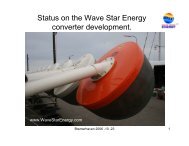Report for EnergiNet - May 2013.pdf - Wave Star
Report for EnergiNet - May 2013.pdf - Wave Star
Report for EnergiNet - May 2013.pdf - Wave Star
You also want an ePaper? Increase the reach of your titles
YUMPU automatically turns print PDFs into web optimized ePapers that Google loves.
<strong>Wave</strong>star Demonstrator, monthly report <strong>for</strong> <strong>May</strong> 2013<br />
Version: 1 Created by: BHE Date: 2013-06-06<br />
Appendix A: Explanations on wave and power measurements<br />
<strong>Wave</strong>s and power production are measured directly on-board the <strong>Wave</strong>star prototype. An ultrasonic wave<br />
sensor is providing wave recordings at the exact location of the device. The diagram below shows the<br />
different power conversion stages. Two definitions are important in the report.<br />
Hydraulic power, P h [W]: The hydraulic power is measured at the hydraulic actuator, calculated by<br />
multiplying of the pressure across the cylinder and the flow in the cylinder. The hydraulic power of the<br />
prototype is the sum of the hydraulic power of both floats, P h = P h1 + P h2 . The hydraulic energy, referred to as<br />
E h , is the integration of the instantaneous hydraulic power over time.<br />
Electrical power, P e [W]: The electrical and consequently generated power is measured at the output of the<br />
generator, calculated by multiplying the voltage and the current. The electrical power of the prototype is the<br />
sum of the electric power of both floats, P e = P e1 + P e2 . The electrical energy, referred to as E e , is the<br />
integration of the instantaneous electrical power over time.<br />
Overview of energy conversion stages of the <strong>Wave</strong>star Demonstrator at Hanstholm. The hydraulic power<br />
P h [W] is measured at the hydraulic actuator (pressure across the cylinder multiplied by the flow in the<br />
cylinder). The electrical power P e [W] is measured at the output of the generator (voltage multiplied by<br />
current).<br />
Page 12 of 12



